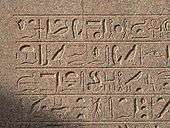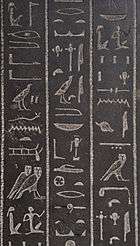
(Example hieroglyph
relief). The Cross-ndj hieroglyph is shown in the bottom line at the beginning (at right)(reads right-to-left):
.
The
ancient Egyptian Cross-n(dj) hieroglyph,
Gardiner sign listed no. Aa27, is a portrayal of a cross-(shape), possibly a 'tool', 'mill'?; it is often portrayed with the common
pot hieroglyph,
nu, no. W24
; the Cross-ndj hieroglyph is displayed in some places in the subset for "agriculture, crafts, and professions", or the "unclassified" category.
In the Egyptian language, the cross-ndj hieroglyph is used as a biliteral for n(dj)-(nḏ).[1]
The hieroglyph is also used as an
ideogram or
determinative. Being used almost exclusively in a
hieroglyph composition block with the nu-pot, (no. W24),
, and plural forms of
grains, or a
grinding stone, the definitions of "to rub out", or "grind" help explain other uses of the glyph.
Book of the Dead uses
Budge's dictionary to the Book of the Dead has the following uses for the hieroglyph:
- 1—(nos 1,2,4)-"to protect, guard, avenge", and "protector, advocate, avenger"
- 2—(no. 3)-"homage to thee", (a form of salutation to gods)
3
—(nos. 5,6,7)-"discuss a matter with someone", "to converse", "to take counsel"; (uses the 'man-seated hieroglyph' for 'concepts', or 'speech', no. A2)
Usage with the nu-pot hieroglyph
Budge's two-volume dictionary has entries for "rub out" and "grind", both connected to
Coptic language words. Of the thirty-three entries, six refer to these two definitions. Entry 24 refers to the Coptic word (n-o-u-t)-(nout), and 29 to (n-o-e-i-t)-(noeit); dictionary entry 24 has seven spellings using
determinatives for "grinding", the block-of-stone (hieroglyph), no. 39,
, or the man-grinding (hieroglyph), no. 34 (actually unlisted, a man grinding upon a
stone-block-mortar),
Entry 29, (six spellings, and Coptic word (noeit)), uses the small circle for
grain, no. N33B,
, or the
plural of grains,
; also another
grain production hieroglyph, nos. U9, U10,
 |
(or) |
 |
|
Rosetta Stone usage
There are five
[3] distinct uses of the
cross-ndj hieroglyph in the
Rosetta Stone. As
Ptolemy V the author of the stone, his great-great-grandparents,
Ptolemy I and Queen-wife are referenced twice, at lines R6 (Rosetta), and line N3 (
Nubayrah Stele). The hieroglyph is used to refer to the husband-wife twin parents,
ne(tsh)erui, ne(ch)erui, (nḏrui),
, and uses the "god" hieroglyph, a flag-type glyph.
Two more uses refer to the word "Avenger". In line N10, referring to Ptolemy V: "....he (Ptolemy V) in the semblance of Horus, son of Isis, son of Osiris, the avenger of his father Osiris; Behold His Majesty with the heart of..." Line R6 (Rosetta) starts the listing of the ten rewards to be made to Ptolemy V (including the erecting of the Rosetta Stone). A statue of Ptolemy V is to be made and erected upon an altar, and the statement to be made: the accolades: "...."Ptolemy, the Avenger of Baq-t"-(Egypt), the interpretation whereof is "Ptolemy, the strong one of Kam-t"-(Egypt), and a statue of the god of the city giving to him a sword royal-(khepesh) of victory,..."
The fifth use is from line R5, and is for 'concerning himself'-(nedji): "...Behold His Majesty [had] the heart of a god perfect towards the gods, concerning himself with the affairs(?) of the temples beautiful,..." (Only this usage, and line R6, "Avenger of Baq-t" use the complement of the nu-pot hieroglyph.)
See also
References
- ↑ Schumann-Antelme, and Rossini, 1998. Illustrated Hieroglyphics Handbook, Biliterals, B48, nedj, mill?, tool?, p168-169.
- ↑ Budge, 1991. A Hieroglyphic Dictionary to the Book of the Dead, "netch", p. 226.
- ↑ Budge, 1989, (1929). The Rosetta Stone, pp. 126, 133, 152, 155.
- Budge, 1978, (1920). An Egyptian Hieroglyphic Dictionary, E.A.Wallace Budge, (Dover Publications), c 1978, (c 1920), Dover edition, c 1978; cliv-(154) and 1314 pp. (In two volumes) (softcover, ISBN 0-486-23615-3)
- Budge, 1991. A Hieroglyphic Dictionary to the Book of the Dead, E.A.Wallace Budge, Dover edition, 1991; Original: c 1911 as: A Hieroglyphic Vocabulary to the Theban Recension of the Book of the Dead with an Index to All the English Equivalents of the Egyptian Words, (Kegan Paul, etc. Ltd, London, publisher). Dover: (softcover, ISBN 0-486-26724-5)
- Budge. The Rosetta Stone, E.A.Wallace Budge, (Dover Publications), c 1929, Dover edition(unabridged), 1989. (softcover, ISBN 0-486-26163-8)
- Collier, Mark, and Manley, Bill, How to Read Egyptian Hieroglyphs, c 1998, University of California Press, 179 pp, (with a word Glossary, p 151-61: Title Egyptian-English vocabulary; also an "Answer Key", 'Key to the exercises', p 162-73) {hardcover, ISBN 0-520-21597-4}
- Schumann-Antelme, and Rossini, 1998. Illustrated Hieroglyphics Handbook, Ruth Schumann-Antelme, and Stéphane Rossini. c 1998, English trans. 2002, Sterling Publishing Co. (Index, Summary lists (tables), selected uniliterals, biliterals, and triliterals.) (softcover, ISBN 1-4027-0025-3)


 Hieroglyphs from coffin of Ankhnesneferibre
Hieroglyphs from coffin of Ankhnesneferibre